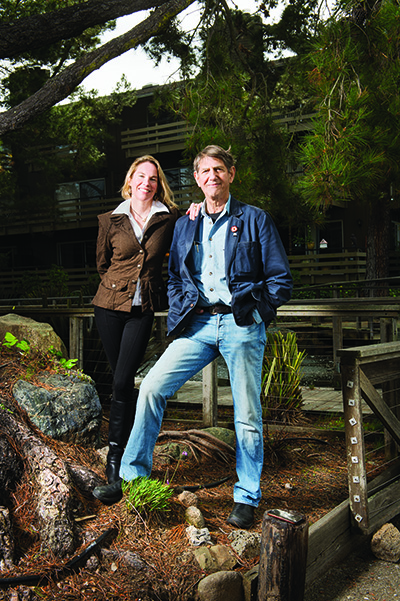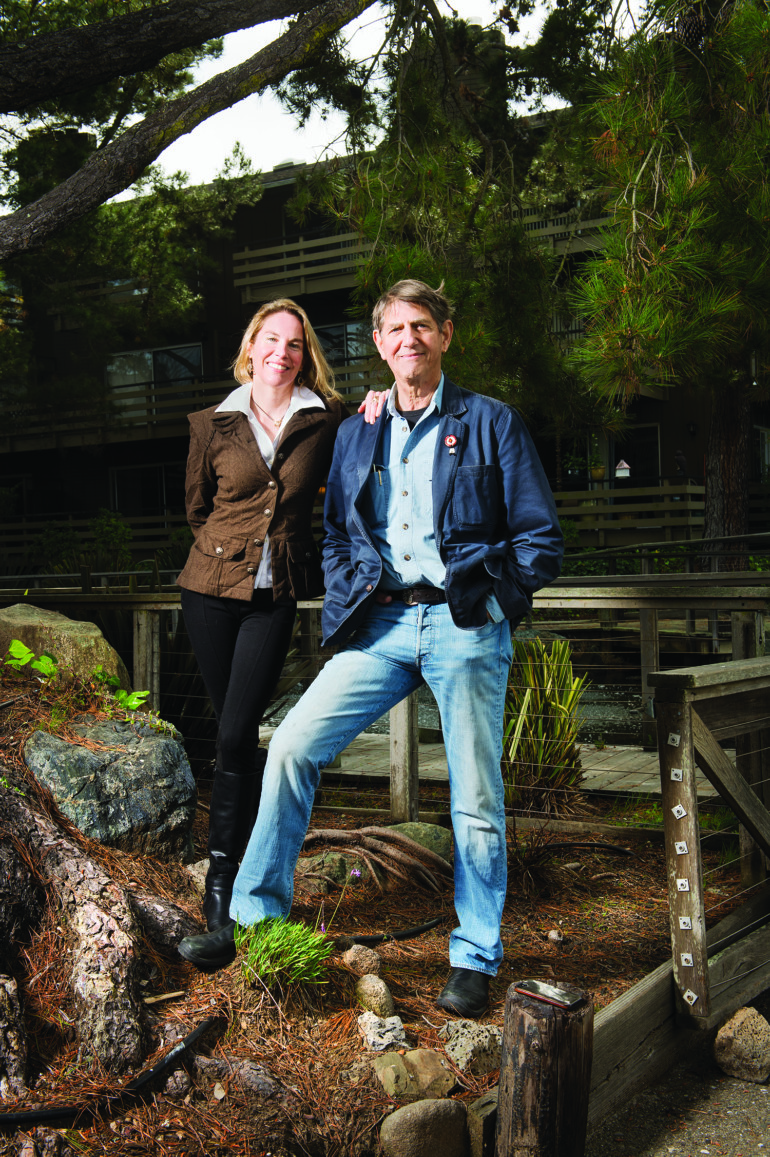 To kick off last fall’s inaugural Marin Conversations series, a North Bay affiliate of San Francisco’s Commonwealth Club, celebrated actor and activist Peter Coyote took the stage at Mill Valley’s Outdoor Art Club with Camilla Fox, founder and executive director of Larkspur-based Project Coyote (where Peter serves on the advisory board). The two came together to speak about their efforts to protect the often-maligned and feared canine predators, including wolves, coyotes and foxes. While it’s tempting to have fun with their highly appropriate names, both Fox and Coyote are very serious about working together to make a difference.
To kick off last fall’s inaugural Marin Conversations series, a North Bay affiliate of San Francisco’s Commonwealth Club, celebrated actor and activist Peter Coyote took the stage at Mill Valley’s Outdoor Art Club with Camilla Fox, founder and executive director of Larkspur-based Project Coyote (where Peter serves on the advisory board). The two came together to speak about their efforts to protect the often-maligned and feared canine predators, including wolves, coyotes and foxes. While it’s tempting to have fun with their highly appropriate names, both Fox and Coyote are very serious about working together to make a difference.
Born Robert Peter Cohon, the son of Ruth and Morris Cohon, in New Jersey in 1941, Peter Coyote (he changed his name in 1966) and Camilla Hovey Fox, born in St. Louis Missouri, daughter of Bonnie and Michael Fox, a prominent canid researcher, are involved in a nationwide effort to teach the public about protection and the ecological benefit of apex (top-level) predators. That these wild animals benefit ecosystems can be a hard to sell to those with cats and small dogs or farmers with livestock to guard.
What has happened since your appearance at Marin Conversations? CF: We’ve had several very positive victories for wildlife. The California Fish and Game Commission voted 3 to 2 to move our petition forward to ban predator-killing contests statewide. If we prevail, this will set the precedent for the nation. Most people are shocked to learn that it is legal to kill coyotes, foxes, bobcats and other wildlife as part of a tournament for prizes and “recreational fun.” They’re even more shocked to learn that thousands of such contests take place each year in the U.S., killing tens of thousands of wild animals. Back in April, the Los Angeles city council voted unanimously to ban snares and other body-gripping traps citywide. And California banned the residential sale of toxic rat poisons, which can kill wildlife as well as companion animals.
Anything to look out for this month? CF: Yes. On June 4 the California Fish and Game Commission will hold another public hearing in Fortuna on our petition to ban predatorkilling contests and on a proposal to list gray wolves under the California Endangered Species Act. If people are interested in learning about these issues and opportunities to get involved, we encourage them to visit our website, projectcoyote.org. We’re also launching our Coyote Coexistence Plan with the Town of Superior, Colorado, and expanding our partnerships with San Francisco as well as several other cities and communities across the country to model Project Coyote’s success here in Marin.
Camilla, of all careers, how did you become an advocate for wildlife and apex predators? After working in the field of animal and environmental protection for more than 15 years, I saw a need for an organization that would be a voice and an advocate for the most maligned wild animals in North America: predators. Like Native Americans of this country, predators have been persecuted, maligned and misunderstood for centuries. We kill them in vast numbers with unimaginable methods from poisoning to aerial gunning to “denning” — the killing of coyote and fox pups in their dens. I grew up with predators in my midst, as my father studied wild canid behavior. We had a rescued timber wolf named Tiny. She was an orphan who would have otherwise been put down; she was part of our family for 15 years.
When did you decide to become an advocate for animals? PC: I grew up in the country and got a gun when I was 10 years old. I loved hanging out with our family’s ranch manager, Jim; he was an ex–game warden with a passion for nature, and he was my hero. He had protected the egrets in Florida from milliners from New York hunting their feathers. He took me hunting, taught me how to remove the human scent from traps by boiling them in maple bark, taught me how to set them. One day, we were walking in the woods and we approached one of the traps we’d set. I was so excited. I thought, I get to see a wild animal up close. It was a weasel. It just sat up and looked and me. It was injured, trapped by its hind leg. I heard it, inside my mind, say, “What are you going to do to me?” and I was so startled, I looked at Jim thinking he heard it too. But he killed it. The next day we caught a raven and it said the same thing. I said, “Let’s not kill it, Jim. Let’s let it go,” but it was wounded and he killed it. It’s one of the reasons I always feed ravens today. It was indisputable to me in that moment that they were, like me, alive. I wish I could say I stopped hunting at that point. I didn’t, but that experience planted a seed that I couldn’t ignore. If you grow up on a farm your relationship to life and death is always bittersweet — you feed your chickens and then you are eating them, or you feed your pigs and then you eat them. That bittersweet ambivalence has been with humans for centuries. It’s why we have ceremonies, like saying grace over our food. It’s a recognition that life is complex. CF: I knew from a young age that I wanted to dedicate my life to protecting animals and the wild. I rescued animals when I was barely out of diapers, became a vegetarian when I was 6, refused to dissect animals in school and cofounded Boston University’s Students for the Ethical Treatment of Animals when I was 18. From then on I have solely worked in the nonprofit field of animal and environmental protection. I’m grateful to be able to follow my passion and my bliss, as Joseph Campbell would say.

John Harrison
What’s your message to adults who feel they have grown out of their animal-loving phase? PC: Lots of people have pets and pets are usually the objects of their uncritical affection. There is another side to pets that we sort of forget, which is, if you live with a dog or a cat, in short order you learn clearly that you can communicate with them. You know their moods and realize without a doubt that they are sentient beings, with their own purpose for being alive, not yours. People will talk about them like they are members of their family: “So-and-so is cranky today, or tired.” This relationship is common, but it is the tip of the iceberg in the experience of relating to another species. If you stop to think about your pets, they are like a challenged child compared to the intelligence and emotional potential of a wild animal.
Camilla, describe your work with the farmers in West Marin. What worked, what didn’t? In 1996 we learned that our county was going to allow the U.S. Department of Agriculture “Wildlife Services” to experiment with a very dangerous poison known as Compound 1080 to kill coyotes and other predators on West Marin ranches — ostensibly to protect livestock. We formed the Marin Coalition for California Wildlife to try to stop the use of this poison and to seek alternatives to the killing of native carnivores. We met with the County Board of Supervisors and generated hundreds of letters from Marin residents who wanted a different approach. Our county responded by bringing the ranchers and our coalition together in mediated discussions. We listened, they listened, common ground was established and the Marin County Livestock and Wildlife Protection Program was established. Their goal was to protect their animals and our goal was to help find an alternative to the existing federal program, which depended largely on indiscriminate lethal methods.
It’s been 14 years; how has it been working? According to the Marin County Department of Agriculture, Weights and Measures, which oversees the program, livestock losses have been reduced as well as costs. More ranchers are recognizing the benefits of living with coyotes and other predators that help to keep rodent populations down (for example, one coyote can consume more than 1,800 rodents in a year) as well as keeping transient juveniles out who may be more prone to hunt novel prey like livestock. And many ranchers are thrilled to see how effective guard animals like Great Pyrenees, Anatolian shepherds, llamas and alpacas can be in deterring predators. It’s truly amazing to see these animals in action — doing what they do best.
Are there more coyotes recently? CF: Coyotes — along with many other predators — were shot, trapped and poisoned to the point of extirpation in parts of their historical range including parts of Marin County. They have recovered in many areas. When not exploited (e.g. indiscriminately trapped, poisoned, etc.), they self-regulate and maintain stable family groups. When they’re exploited, their populations can actually increase. We know this from decades of research — and yet our federal government still relies heavily on indiscriminate killing methods. We estimate that at least 500,000 coyotes are killed each year in the U.S. alone — that’s one per minute.
Key things to think about regarding coexisting? PC: Coyotes are the Jews of the animal world. Since the 1920s they have been gassed, snared, poisoned and hunted from planes with the aim of eliminating the species. But they have survived and flourished. All these efforts have managed to accomplish is to spread coyote populations from their original territory in the West and Midwest to all over the country. We live in a county that is over half open space. It is their territory where they feed, where they get water. If I don’t make some exception for them, if I don’t open my life for them in some way, I am obliterating their environment and I am actually expressing selfishness no matter how “green” I may advertise myself to be.
How do predators, like coyotes benefit an ecosystem? PC: Everybody loves the forest, right? Everybody loves trees, but if you kill off the apex predators like wolves and coyotes, the trees won’t survive. The coyotes keep down the porcupines, rodents and deer that eat the shoots of the trees — it happens very quickly, in several seasons.
What do you think is in human nature that encourages us to domesticate animals? CF: Fear factor. We have to recognize that we are part of the ecosystem. When we came out of the trees walking upright on the plains of Africa we had a visceral and understandable fear,of predators. After all, we were potential prey. Project Coyote acknowledges that fear. But as we grapple with the repercussions of losing the wild — both wildlife and wildlands — and as our children become more separated from the wild with computers, cellphones and technology, it becomes all the more imperative that we preserve the wild for future generations.

Mimi Towle has been the editor of Marin Magazine for over a decade. She lived with her family in Sycamore Park and Strawberry and thoroughly enjoyed raising two daughters in the mayhem of Marin’s youth sports; soccer, swim, volleyball, ballet, hip hop, gymnastics and many many hours spent at Miwok Stables. Her community involvements include volunteering at her daughter’s schools, coaching soccer and volleyball (glorified snack mom), being on the board of both Richardson Bay Audubon Center. Currently residing on a floating home in Sausalito, she enjoys all water activity, including learning how to steer a 6-person canoe for the Tamalpais Outrigger Canoe Club. Born and raised in Hawaii, her fondness for the islands has on occasion made its way into the pages of the magazine.


